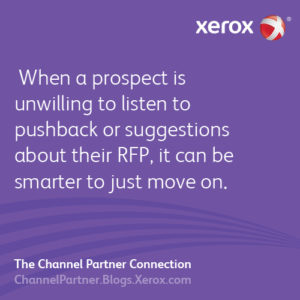
Discussion spotlight: RFP dilemmas
Recently Adam Johnson, director at Limpio MPS, provided some great input to the question,
“When should you say NO to an RFP/bids and tender request?”
This question arose after we posted our 10 Top Tips for Winning Large Bids and Tenders article. A commenter mentioned that sometimes you have to say “thanks, but no thanks” to pricing requests. If you’ve been in the business for a while, then you no doubt have some great examples of requests that just didn’t feel right.
Maybe the financials just didn’t make sense.
Maybe it was obvious that the incumbent vendor was heavily influencing the direction of the RFP.
Or maybe it was something else entirely.
To bid or not to bid, that is the question
We all know that all RFP, bid and tender requests are not created equal. Depending on how requests are written or the process is handled, they can give the customer all of the control. It’s often hard to know if a company is serious about an RFP or if they are just going through the motions to meet internal requirements and have already decided to hand the work off to a favorite supplier.
Adam Johnson and Limpio MPS typically proceed with caution. Johnson says that “while saying no to an RFP can be difficult, it’s important to consider whether or not a deal fits with your company’s value proposition and how the request was handled”.
If the client has been engaged with us and the other potential suppliers prior and invited the organizations that they were comfortable with (assuming they can, and not have to have an open tender) then yes of course. If we haven’t been engaged with the client previously, then no, it will have either been already decided who would win or it will be based purely on price as opposed to quality and value of the offering. I must admit that we have responded to RFPs in this way before, as it is difficult to shake the belief that we could not win it, but you have to be pragmatic about it.
3 RFP red flags that should send you running
1. Price blinders: Does the prospect care about the value your company provides beyond a good price? Strictly price-based relationships are harder to maintain and can involve more nickel-and-diming than they are worth. Of course, you may be able to prove you provide extra value over time, but be sure to inquire about why your prospect has chosen or dropped other vendors. If service or value never comes up, it’s definitely cause for pause.
2. No pushback: When a prospect is unwilling to listen to pushback or suggestions about their RFP, it can be smarter to just move on. When a prospect isn’t open to suggestions based on your expertise, it can indicate a difficult relationship ahead.
3. No transparency: When a prospect is changing vendors, it’s important to understand what prompted the move. If they won’t tell you, then there’s a good chance it’s a pricing issue, which leads back to red flag #1.
What do you think?
Are these flags concerns for you? Are we missing any? Please share your thoughts below or if you are a Xerox Channel Partner join the Xerox Channel Partners LinkedIn group to read what other Xerox Channel Partners have to say and continue the conversation.
Subscribe to the Channel Partner Connection and receive email updates when we publish a new article.



